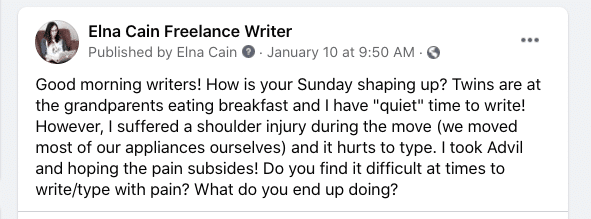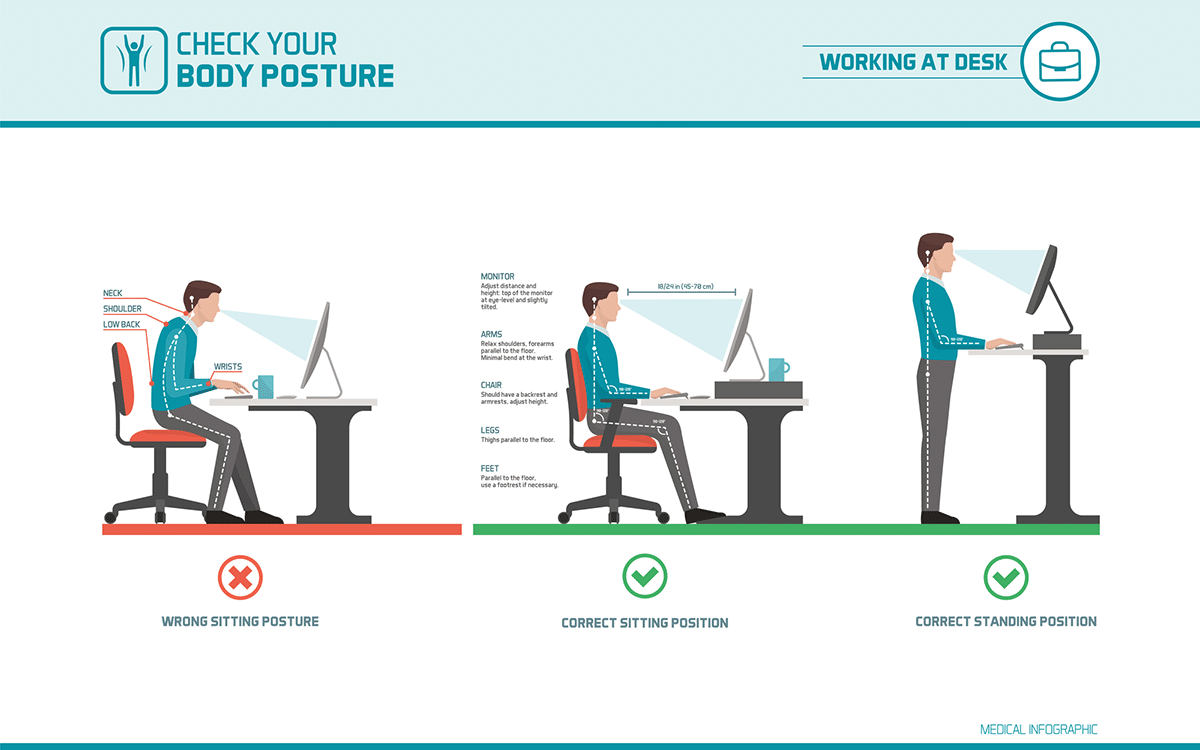How many hours do you spend at your computer as a freelance writer working from home?
Whatever the number, sitting at a desk for prolonged periods of time can have a negative effect on your back and neck.
I should know.

Over the years as a freelance writer I have had to battle RSI – repetitive stress injury – and this creeps up to my neck and back to make me incapable of typing for days.
Recently, I hurt my shoulder from moving appliances (COVID-19 move where my husband and I basically moved all of our appliances to our new house) and it’s been bugging me ever since. I shared my pain on my Facebook page and got a flood of wonderful advice.

And who wants to deal with that kind of pain while building a freelance writing business?
I certainly don’t, especially when I have my little ones and a household to take care of as well.
While dealing with neck and back pain can be an occupational hazard for freelance writers, it certainly doesn’t have to be!
The following solutions are not only a great way to deal with existing back and neck pain but can also help in preventing it.
Why Do Freelance Writers Experience Back and Neck Pain?
The short answer is: Because we spend a lot of time sitting at our computer.
While there is nothing wrong with that, it’s the way we sit and position our bodies that lead to back and neck pain.
Think about your posture right now. Are you craning your head forward? Is your back slouched?
When you jut your head forward, this position compresses your neck and forces it to support the weight of your head. The combined weight of your head and neck is about 45 pounds in this position, compared to only 12 pounds when your posture is tall and straight.
This added weight and resulting compression can lead to fatigue, headaches, poor concentration, muscle and tension and even injury.
Eventually, you may experience limitations when it comes to turning your head as well as a stiff neck and stiff shoulders.
This may seem like bad news for freelance writers but, with the following solutions, you can easily avoid back and neck pain while you focus on completing your writing projects and building your business.
6 Solutions for Back and Neck Pain

1. Practice Good Posture *Posture corrector
The number one thing you can do to avoid back and neck pain while working at your computer is to ensure your posture is correct.
Remember what I said above about the weight of your head and neck? When sitting in a proper position, there is far less weight compressing your spine.
To ensure you are sitting properly, follow these steps:
- Sit with your back straight and your shoulders pulled back. Scoot your bum back to touch the end of the seat.
- Keep your neck and head at an upright angle, keeping your ears in line with your shoulders.
- Keep your hips straight and avoid leaning to the side.
- Bend your knees at a 90-degree angle, keeping them even or slightly lower than your hips.
- Try to place your feet flat on the floor or on a footrest.
This may be the most difficult solution to upkeep for long periods of time since we tend to lose focus on our posture and instead pay attention to our freelance writing work.
If that is the case, you can always try a posture corrector like this one that will help you have correct posture when you type from home.
2. Set Up Your Desk Properly
You can encourage your body to maintain good posture by setting up your desk, keyboard and monitor at optimal heights and positions.
Beginning with the desk itself, the most important thing to pay attention to is its height. If your desk is too high, it will cause strain on your forearms as you type. If it’s too low, you’ll hunch over as you work.
When your desk is at the right height, you should be able to comfortably fit your legs under it when your feet are flat on the floor.
The angle between your upper arm and your forearm, while they are at rest on your desk, should be around 90-110 degrees.
Here is a handy diagram to see how to sit properly at your desk.

The next thing you want to look at is the position of your monitor. This is going to determine at what angle you need to hold your head.
It should be positioned at an angle between 10- and 20-degrees.
Any more than that and you will be holding your head at an uncomfortable angle that can cause neck strain and places more weight on your spine.
Height-wise, the top line of your screen should be at or below eye level.
Lastly, look at your keyboard. When you’re typing, your elbows should be relaxed at your side and not behind or in front of you.
Also, your keyboard should tilt away from you slightly rather than toward you and try not to rest your palms on your keyboard. This is something I fail to do and I feel contributes to my RSI pain.
Know that you know where your equipment should be positioned, it’s time to look at the type of equipment you can use to make this easier.
3. Invest in an Adjustable Chair
Changing the height of your desk to accommodate good posture can be difficult or impossible, which is why most freelance writers use an adjustable chair.
Adjustable office chairs give you the option of moving the seat up and down to help you fit properly under your desk.
They also allow you to tilt forward and backward as well as adjust the recline of the back support.
However, just because you can adjust these chairs any which-way doesn’t mean all positions are good for your neck and back.
First of all, adjust your chair for the proper height by standing in front of the chair and raising it or lowering it until the highest point of the seat (where you sit) is just below your knees.
Next, sit in the chair and adjust the backrest until it fits the hollow of your back.
If the chair has armrests, bend your elbows at a 90-degree angle and adjust the armrests until they barely touch under your elbows.
Armrests can be problematic since they are often too large to allow you to sit close enough to your desk. If this is the case, they can be removed.
Now, what happens if you properly adjust your chair and can’t fit under your desk? Or your desk is still too high?
If your desk is too high, raise the chair and use a footrest to support your feet.
This is what I do and have had my trusty little box for years sitting under my desk as support.
If your desk is too low, it may be time for a new desk. Or, depending on the style of your desk, you can use risers under the legs to lift it up.
Unfortunately for me, I have a hard time adjusting to a new office chair. After sitting in a new ergonomic and perfectly beneficial office chair, I get neck and back pain and RSI pain in my hands.
So, for now, I’ve been freelancing sitting on a cheap office chair that I got before I had my twins!
4. Use an Ergonomic Keyboard
When you’re freelance writing from home, you are typing – A LOT.
Why not alleviate the strain on your wrists and back by using an ergonomic keyboard?
I have one and, let me tell you, I would never go back to a regular keyboard!
Ergonomic keyboards are designed to accommodate the position of your hands, arms and shoulders when you practice proper posture.
This is the one my husband and I use and have used for many years.
Give it a try: Rest your fingers on your keyboard in a typing position. Now relax your shoulders are your elbows. Notice how your hands roll out and your elbows move closer to your body?
Ergonomic keyboards are designed for this natural position and make it easier to maintain a good posture while doing your freelance writing work.
They do this by offering features such as:
- Tenting: allows you to adjust the vertical angle of the keyboard
- Splitting: allows you to adjust the angle of the left and right sides independently)
- Splaying: places the keyboard in a “v” formation
- Tilt Angling: allows you to adjust the horizontal tilt of the keyboard.
When looking for an ergonomic keyboard, look for ones that offer a wide range of adjustability as well as keys that can be easily pushed while typing – this will limit the force you have to use for each keystroke.
If you work on a laptop, you’re going to want to get an ergonomic keyboard with a wireless connection such as Bluetooth or a USB connection.
5. Try a Standing Desk
Yes, standing desks are a thing. In fact, my husband uses one while he works from home!
It’s been proven that sitting too much is really bad for your health.
A standing desk not only helps with neck and back pain but can also lower your risk of weight gain and improve your mood and energy levels.
When it comes to back and neck pain, a standing desk can help improve your posture and relieve pressure off your neck and lower back.
However, just like adjustable chairs, using a standing desk improperly can cause more harm than good.
Here are the best ways to use a standing desk:
- Adjust it to the proper height. Set the desk so you are standing with your head, neck and spine aligned. Position your head slightly back, straighten your hips and let your spine settle into a slight “S” curve. You should be able to rest your wrists flat on the desk with your elbows at a 90-degree angle and your monitor at or below eye level.
- Pay attention to your feet. Standing on a hard surface can cause soreness in your feet and legs. Wear comfortable shoes or stand on a cushioned mat.
- Give yourself time to get used to it. If you’re going from sitting all day to standing, your body needs time to adjust. Start with 30 minutes at a time and work your way up to standing in blocks of one hour, two hours and four hours until you can stand comfortably all day.
Even if you can stand for several hours while working from home, it’s important to take breaks to allow your body an opportunity to stretch and move around.
6. Take Breaks to Stretch

It’s a good thing that you don’t sit or stand for more than 30 minutes without taking a quick break to get up and move around.
You can take these opportunities to grab a glass of water or run to the bathroom.
Stretching is also a great way to spend these short breaks. Every 30 minutes, try one of these stretches:
- Shoulder Shrug. While standing, lift your shoulders up toward your ears and squeeze them as hard as you can. Hold for a couple of seconds and roll them back as you relax. Repeat 8-10 times.
- Torso Stretch. Stand up and lace your fingers together. Stretch them up toward the ceiling as high as you can while taking a deep breath. Exhale and open your arms, returning them to your sides. Repeat 8-10 times.
- Upper Back Stretch. Stretch your arms straight out and rotate your hands so your palms are facing away from each other. Cross your arms and press your palms together while rounding your back. Reach away from your body as you relax your head.
- Neck Relaxer. Drop your head slowly to the left and try to touch your ear to your shoulder then repeat on the right side. Slowly drop your chin to your chest and turn your head to the left then to the right.
You don’t have to wait until 30 minutes to do these stretches and most can be done right in your chair.
Not only is stretching beneficial to your body but it will also help you increase your attention and focus on your freelance writing work!
Neck & Back Pain As a Freelance Writer
Just making small changes to the way you position your body while working can make a positive impact on the health of your neck and back!
I would hate to see any freelance writer give up on their dream because working at a computer is too demanding and painful.
So if you find yourself dealing with back and neck pain, try these solutions to alleviate the discomfort.
However, if you are experiencing serious issues with your neck and back, and nothing works or helps, don’t hesitate to talk to your doctor about any underlying issues or causes.
Otherwise, take care of your body and keep on writing!
How about you?
Are there any tips you have for working at a computer comfortably? Share them in the comments!





6 Comments